Comprehensive Report: Medication Support in Social Care Settings
VerifiedAdded on 2020/09/17
|8
|2215
|28
Report
AI Summary
This report examines the critical aspects of medication support within social care settings. It begins by outlining the current legal legislations that govern such environments, including the Medicines Act 1968 and the Health Act 2006, emphasizing the importance of compliance and patient safety. The report then delves into the roles and responsibilities of various healthcare professionals, such as care workers, nurses, and pharmacists, in supporting medication use. It describes how information about an individual's medication is accessed, primarily through Medication Administration Record (MAR) sheets, and details the different routes of medication administration, including oral, sublingual, and parenteral routes. The report also covers the different forms in which medication may be presented and the ways in which equipment can assist in administration. Furthermore, it addresses the data that must be recorded regarding medication use, the safe storage of different medications, and the proper disposal of unused or unwanted medications. The conclusion underscores the significance of adhering to legal regulations, maintaining accurate records, and ensuring the safety and well-being of service users in social care settings.
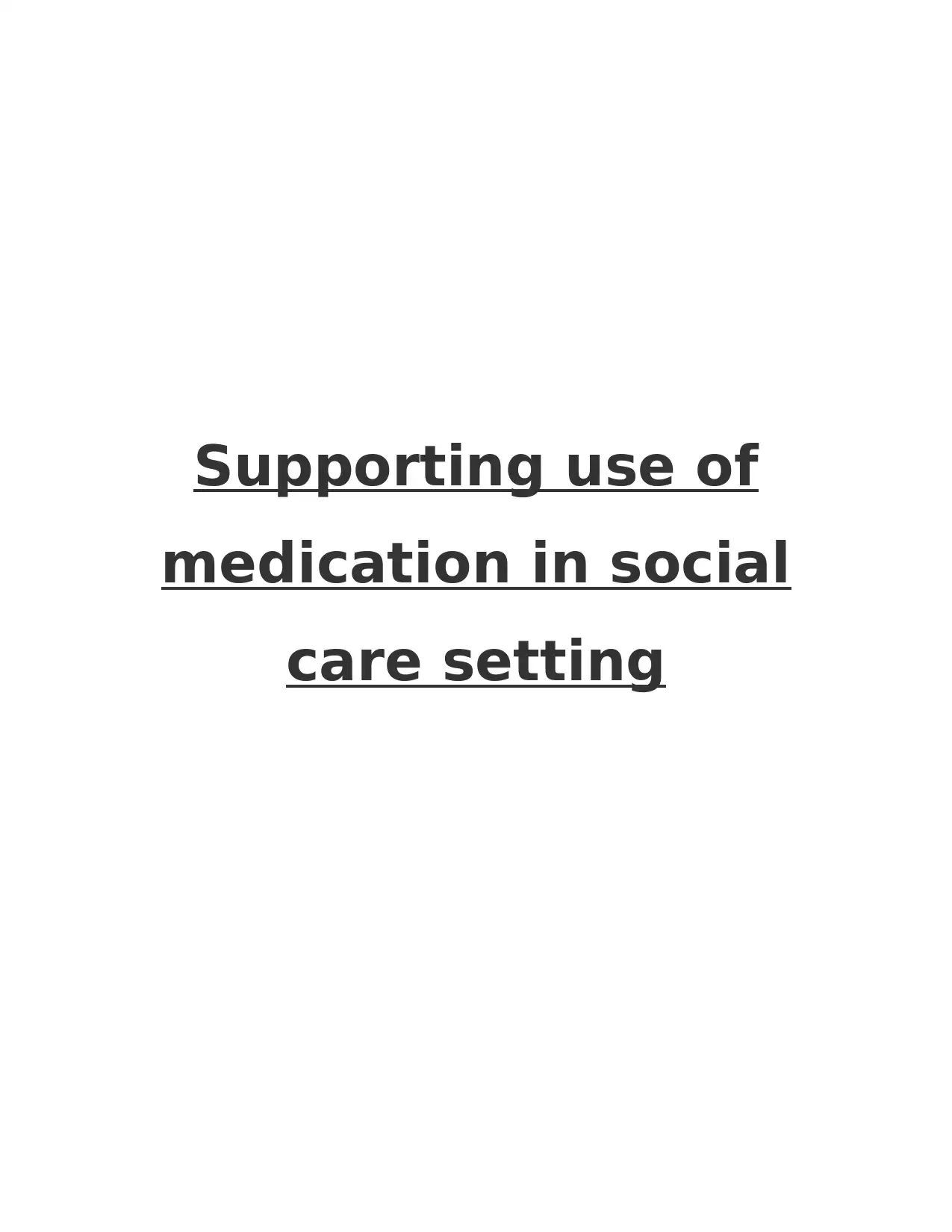
Supporting use of
medication in social
care setting
medication in social
care setting
Paraphrase This Document
Need a fresh take? Get an instant paraphrase of this document with our AI Paraphraser
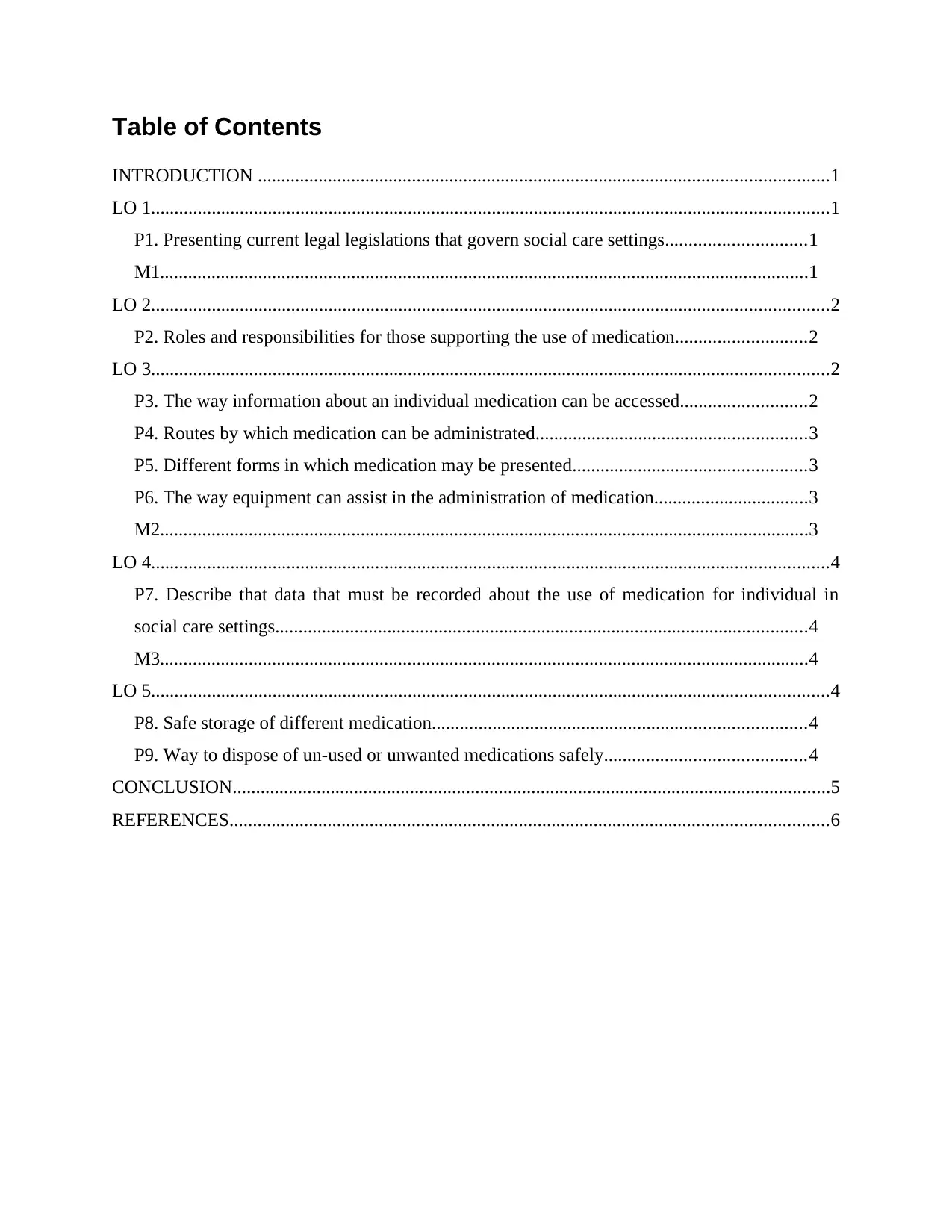
Table of Contents
INTRODUCTION ..........................................................................................................................1
LO 1.................................................................................................................................................1
P1. Presenting current legal legislations that govern social care settings..............................1
M1...........................................................................................................................................1
LO 2.................................................................................................................................................2
P2. Roles and responsibilities for those supporting the use of medication............................2
LO 3.................................................................................................................................................2
P3. The way information about an individual medication can be accessed...........................2
P4. Routes by which medication can be administrated..........................................................3
P5. Different forms in which medication may be presented..................................................3
P6. The way equipment can assist in the administration of medication.................................3
M2...........................................................................................................................................3
LO 4.................................................................................................................................................4
P7. Describe that data that must be recorded about the use of medication for individual in
social care settings..................................................................................................................4
M3...........................................................................................................................................4
LO 5.................................................................................................................................................4
P8. Safe storage of different medication................................................................................4
P9. Way to dispose of un-used or unwanted medications safely...........................................4
CONCLUSION................................................................................................................................5
REFERENCES................................................................................................................................6
INTRODUCTION ..........................................................................................................................1
LO 1.................................................................................................................................................1
P1. Presenting current legal legislations that govern social care settings..............................1
M1...........................................................................................................................................1
LO 2.................................................................................................................................................2
P2. Roles and responsibilities for those supporting the use of medication............................2
LO 3.................................................................................................................................................2
P3. The way information about an individual medication can be accessed...........................2
P4. Routes by which medication can be administrated..........................................................3
P5. Different forms in which medication may be presented..................................................3
P6. The way equipment can assist in the administration of medication.................................3
M2...........................................................................................................................................3
LO 4.................................................................................................................................................4
P7. Describe that data that must be recorded about the use of medication for individual in
social care settings..................................................................................................................4
M3...........................................................................................................................................4
LO 5.................................................................................................................................................4
P8. Safe storage of different medication................................................................................4
P9. Way to dispose of un-used or unwanted medications safely...........................................4
CONCLUSION................................................................................................................................5
REFERENCES................................................................................................................................6
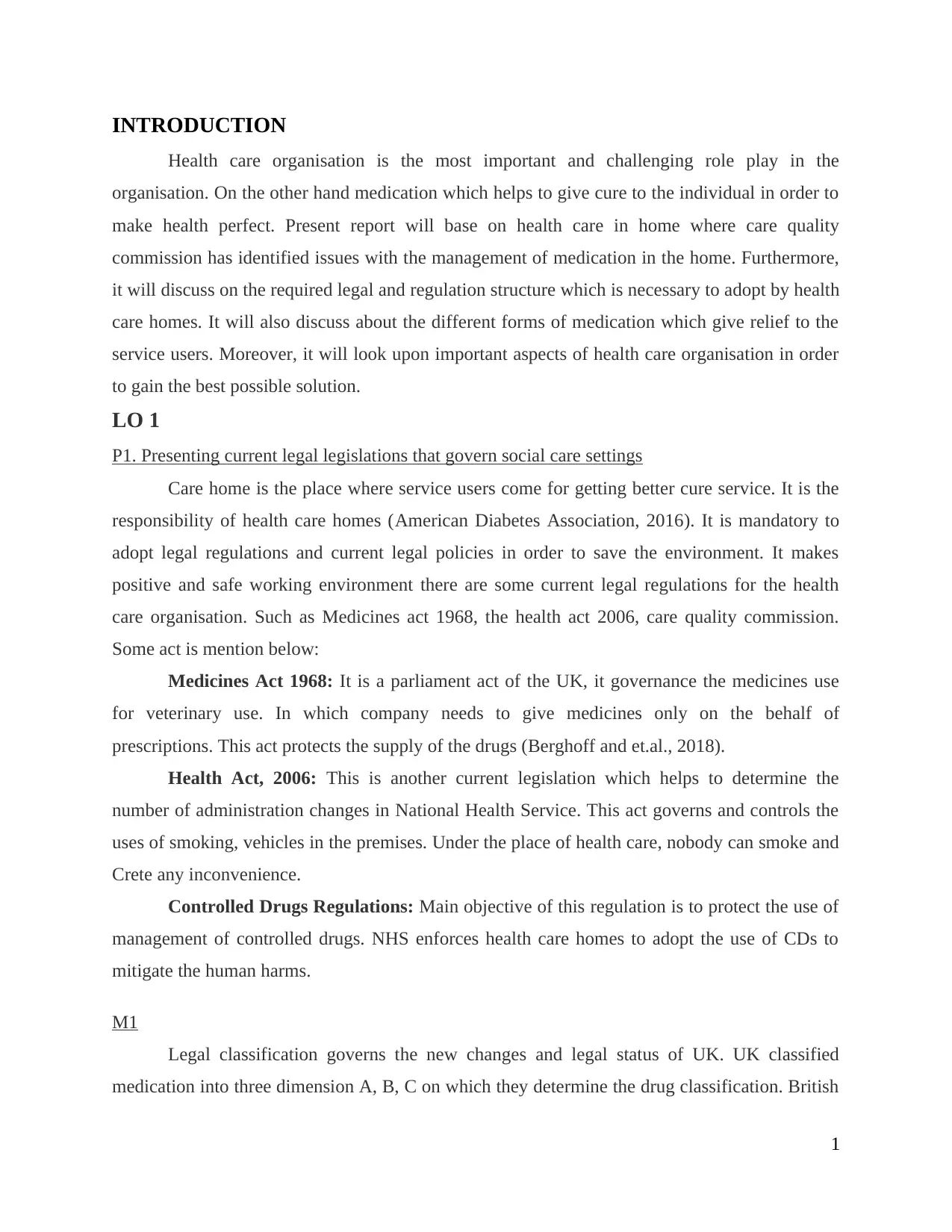
INTRODUCTION
Health care organisation is the most important and challenging role play in the
organisation. On the other hand medication which helps to give cure to the individual in order to
make health perfect. Present report will base on health care in home where care quality
commission has identified issues with the management of medication in the home. Furthermore,
it will discuss on the required legal and regulation structure which is necessary to adopt by health
care homes. It will also discuss about the different forms of medication which give relief to the
service users. Moreover, it will look upon important aspects of health care organisation in order
to gain the best possible solution.
LO 1
P1. Presenting current legal legislations that govern social care settings
Care home is the place where service users come for getting better cure service. It is the
responsibility of health care homes (American Diabetes Association, 2016). It is mandatory to
adopt legal regulations and current legal policies in order to save the environment. It makes
positive and safe working environment there are some current legal regulations for the health
care organisation. Such as Medicines act 1968, the health act 2006, care quality commission.
Some act is mention below:
Medicines Act 1968: It is a parliament act of the UK, it governance the medicines use
for veterinary use. In which company needs to give medicines only on the behalf of
prescriptions. This act protects the supply of the drugs (Berghoff and et.al., 2018).
Health Act, 2006: This is another current legislation which helps to determine the
number of administration changes in National Health Service. This act governs and controls the
uses of smoking, vehicles in the premises. Under the place of health care, nobody can smoke and
Crete any inconvenience.
Controlled Drugs Regulations: Main objective of this regulation is to protect the use of
management of controlled drugs. NHS enforces health care homes to adopt the use of CDs to
mitigate the human harms.
M1
Legal classification governs the new changes and legal status of UK. UK classified
medication into three dimension A, B, C on which they determine the drug classification. British
1
Health care organisation is the most important and challenging role play in the
organisation. On the other hand medication which helps to give cure to the individual in order to
make health perfect. Present report will base on health care in home where care quality
commission has identified issues with the management of medication in the home. Furthermore,
it will discuss on the required legal and regulation structure which is necessary to adopt by health
care homes. It will also discuss about the different forms of medication which give relief to the
service users. Moreover, it will look upon important aspects of health care organisation in order
to gain the best possible solution.
LO 1
P1. Presenting current legal legislations that govern social care settings
Care home is the place where service users come for getting better cure service. It is the
responsibility of health care homes (American Diabetes Association, 2016). It is mandatory to
adopt legal regulations and current legal policies in order to save the environment. It makes
positive and safe working environment there are some current legal regulations for the health
care organisation. Such as Medicines act 1968, the health act 2006, care quality commission.
Some act is mention below:
Medicines Act 1968: It is a parliament act of the UK, it governance the medicines use
for veterinary use. In which company needs to give medicines only on the behalf of
prescriptions. This act protects the supply of the drugs (Berghoff and et.al., 2018).
Health Act, 2006: This is another current legislation which helps to determine the
number of administration changes in National Health Service. This act governs and controls the
uses of smoking, vehicles in the premises. Under the place of health care, nobody can smoke and
Crete any inconvenience.
Controlled Drugs Regulations: Main objective of this regulation is to protect the use of
management of controlled drugs. NHS enforces health care homes to adopt the use of CDs to
mitigate the human harms.
M1
Legal classification governs the new changes and legal status of UK. UK classified
medication into three dimension A, B, C on which they determine the drug classification. British
1
⊘ This is a preview!⊘
Do you want full access?
Subscribe today to unlock all pages.

Trusted by 1+ million students worldwide
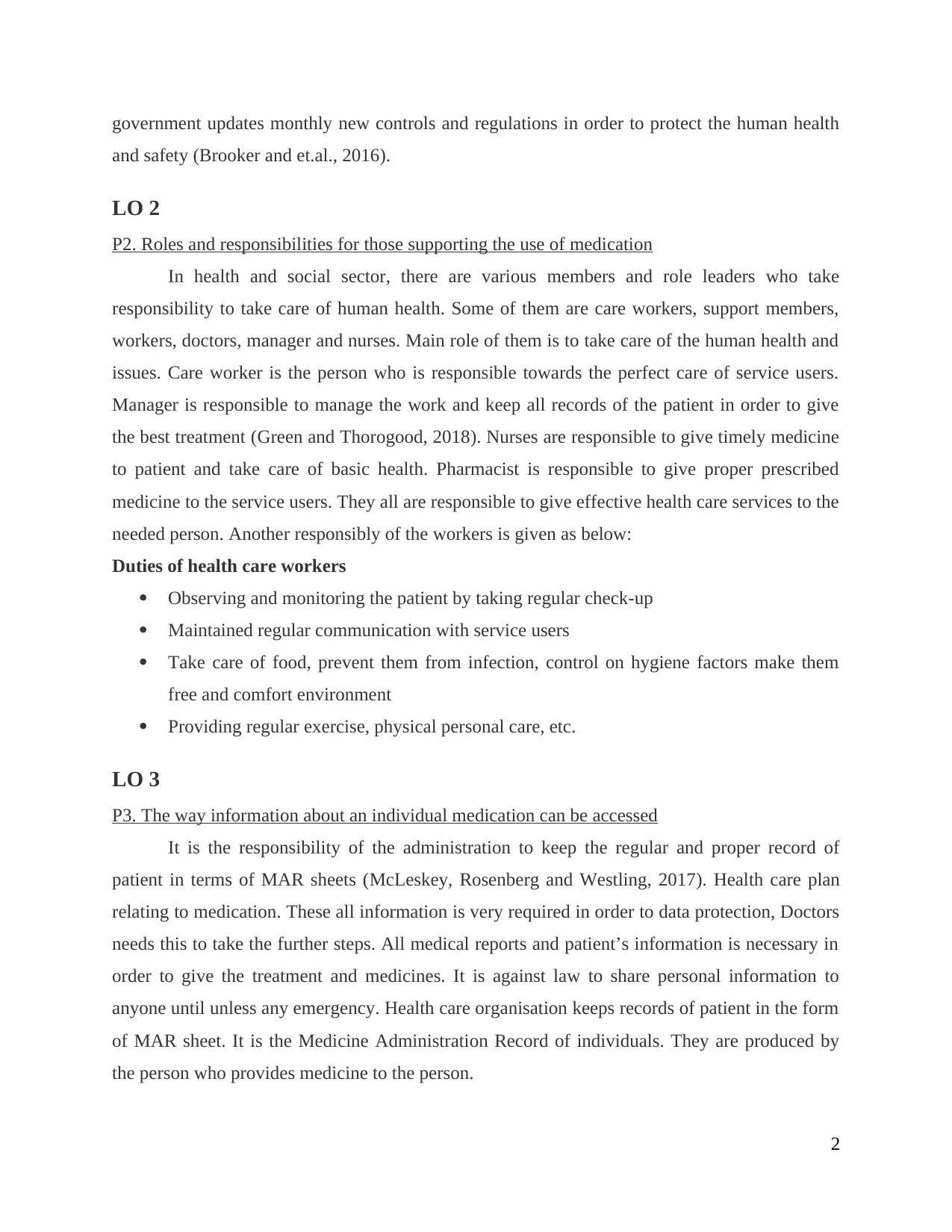
government updates monthly new controls and regulations in order to protect the human health
and safety (Brooker and et.al., 2016).
LO 2
P2. Roles and responsibilities for those supporting the use of medication
In health and social sector, there are various members and role leaders who take
responsibility to take care of human health. Some of them are care workers, support members,
workers, doctors, manager and nurses. Main role of them is to take care of the human health and
issues. Care worker is the person who is responsible towards the perfect care of service users.
Manager is responsible to manage the work and keep all records of the patient in order to give
the best treatment (Green and Thorogood, 2018). Nurses are responsible to give timely medicine
to patient and take care of basic health. Pharmacist is responsible to give proper prescribed
medicine to the service users. They all are responsible to give effective health care services to the
needed person. Another responsibly of the workers is given as below:
Duties of health care workers
Observing and monitoring the patient by taking regular check-up
Maintained regular communication with service users
Take care of food, prevent them from infection, control on hygiene factors make them
free and comfort environment
Providing regular exercise, physical personal care, etc.
LO 3
P3. The way information about an individual medication can be accessed
It is the responsibility of the administration to keep the regular and proper record of
patient in terms of MAR sheets (McLeskey, Rosenberg and Westling, 2017). Health care plan
relating to medication. These all information is very required in order to data protection, Doctors
needs this to take the further steps. All medical reports and patient’s information is necessary in
order to give the treatment and medicines. It is against law to share personal information to
anyone until unless any emergency. Health care organisation keeps records of patient in the form
of MAR sheet. It is the Medicine Administration Record of individuals. They are produced by
the person who provides medicine to the person.
2
and safety (Brooker and et.al., 2016).
LO 2
P2. Roles and responsibilities for those supporting the use of medication
In health and social sector, there are various members and role leaders who take
responsibility to take care of human health. Some of them are care workers, support members,
workers, doctors, manager and nurses. Main role of them is to take care of the human health and
issues. Care worker is the person who is responsible towards the perfect care of service users.
Manager is responsible to manage the work and keep all records of the patient in order to give
the best treatment (Green and Thorogood, 2018). Nurses are responsible to give timely medicine
to patient and take care of basic health. Pharmacist is responsible to give proper prescribed
medicine to the service users. They all are responsible to give effective health care services to the
needed person. Another responsibly of the workers is given as below:
Duties of health care workers
Observing and monitoring the patient by taking regular check-up
Maintained regular communication with service users
Take care of food, prevent them from infection, control on hygiene factors make them
free and comfort environment
Providing regular exercise, physical personal care, etc.
LO 3
P3. The way information about an individual medication can be accessed
It is the responsibility of the administration to keep the regular and proper record of
patient in terms of MAR sheets (McLeskey, Rosenberg and Westling, 2017). Health care plan
relating to medication. These all information is very required in order to data protection, Doctors
needs this to take the further steps. All medical reports and patient’s information is necessary in
order to give the treatment and medicines. It is against law to share personal information to
anyone until unless any emergency. Health care organisation keeps records of patient in the form
of MAR sheet. It is the Medicine Administration Record of individuals. They are produced by
the person who provides medicine to the person.
2
Paraphrase This Document
Need a fresh take? Get an instant paraphrase of this document with our AI Paraphraser
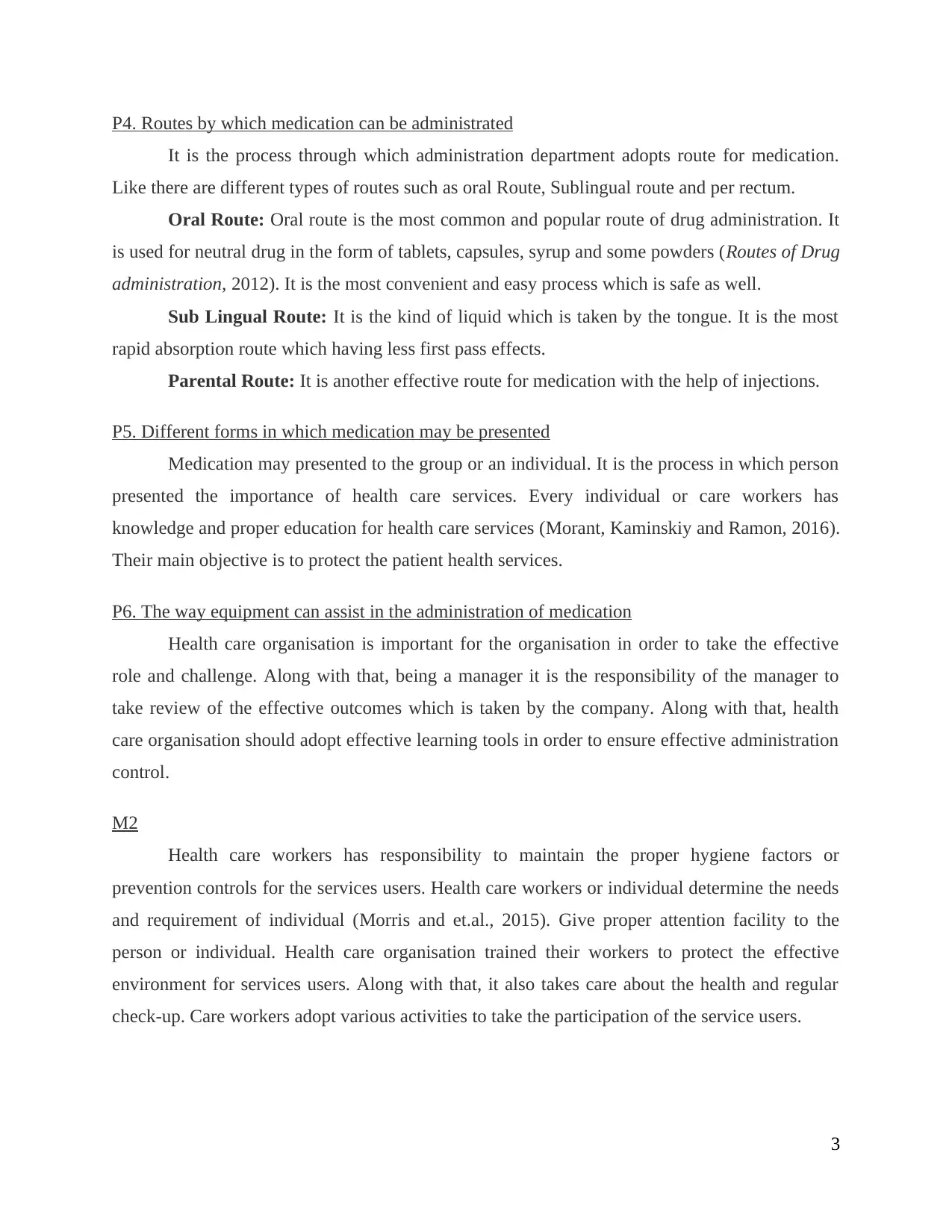
P4. Routes by which medication can be administrated
It is the process through which administration department adopts route for medication.
Like there are different types of routes such as oral Route, Sublingual route and per rectum.
Oral Route: Oral route is the most common and popular route of drug administration. It
is used for neutral drug in the form of tablets, capsules, syrup and some powders (Routes of Drug
administration, 2012). It is the most convenient and easy process which is safe as well.
Sub Lingual Route: It is the kind of liquid which is taken by the tongue. It is the most
rapid absorption route which having less first pass effects.
Parental Route: It is another effective route for medication with the help of injections.
P5. Different forms in which medication may be presented
Medication may presented to the group or an individual. It is the process in which person
presented the importance of health care services. Every individual or care workers has
knowledge and proper education for health care services (Morant, Kaminskiy and Ramon, 2016).
Their main objective is to protect the patient health services.
P6. The way equipment can assist in the administration of medication
Health care organisation is important for the organisation in order to take the effective
role and challenge. Along with that, being a manager it is the responsibility of the manager to
take review of the effective outcomes which is taken by the company. Along with that, health
care organisation should adopt effective learning tools in order to ensure effective administration
control.
M2
Health care workers has responsibility to maintain the proper hygiene factors or
prevention controls for the services users. Health care workers or individual determine the needs
and requirement of individual (Morris and et.al., 2015). Give proper attention facility to the
person or individual. Health care organisation trained their workers to protect the effective
environment for services users. Along with that, it also takes care about the health and regular
check-up. Care workers adopt various activities to take the participation of the service users.
3
It is the process through which administration department adopts route for medication.
Like there are different types of routes such as oral Route, Sublingual route and per rectum.
Oral Route: Oral route is the most common and popular route of drug administration. It
is used for neutral drug in the form of tablets, capsules, syrup and some powders (Routes of Drug
administration, 2012). It is the most convenient and easy process which is safe as well.
Sub Lingual Route: It is the kind of liquid which is taken by the tongue. It is the most
rapid absorption route which having less first pass effects.
Parental Route: It is another effective route for medication with the help of injections.
P5. Different forms in which medication may be presented
Medication may presented to the group or an individual. It is the process in which person
presented the importance of health care services. Every individual or care workers has
knowledge and proper education for health care services (Morant, Kaminskiy and Ramon, 2016).
Their main objective is to protect the patient health services.
P6. The way equipment can assist in the administration of medication
Health care organisation is important for the organisation in order to take the effective
role and challenge. Along with that, being a manager it is the responsibility of the manager to
take review of the effective outcomes which is taken by the company. Along with that, health
care organisation should adopt effective learning tools in order to ensure effective administration
control.
M2
Health care workers has responsibility to maintain the proper hygiene factors or
prevention controls for the services users. Health care workers or individual determine the needs
and requirement of individual (Morris and et.al., 2015). Give proper attention facility to the
person or individual. Health care organisation trained their workers to protect the effective
environment for services users. Along with that, it also takes care about the health and regular
check-up. Care workers adopt various activities to take the participation of the service users.
3
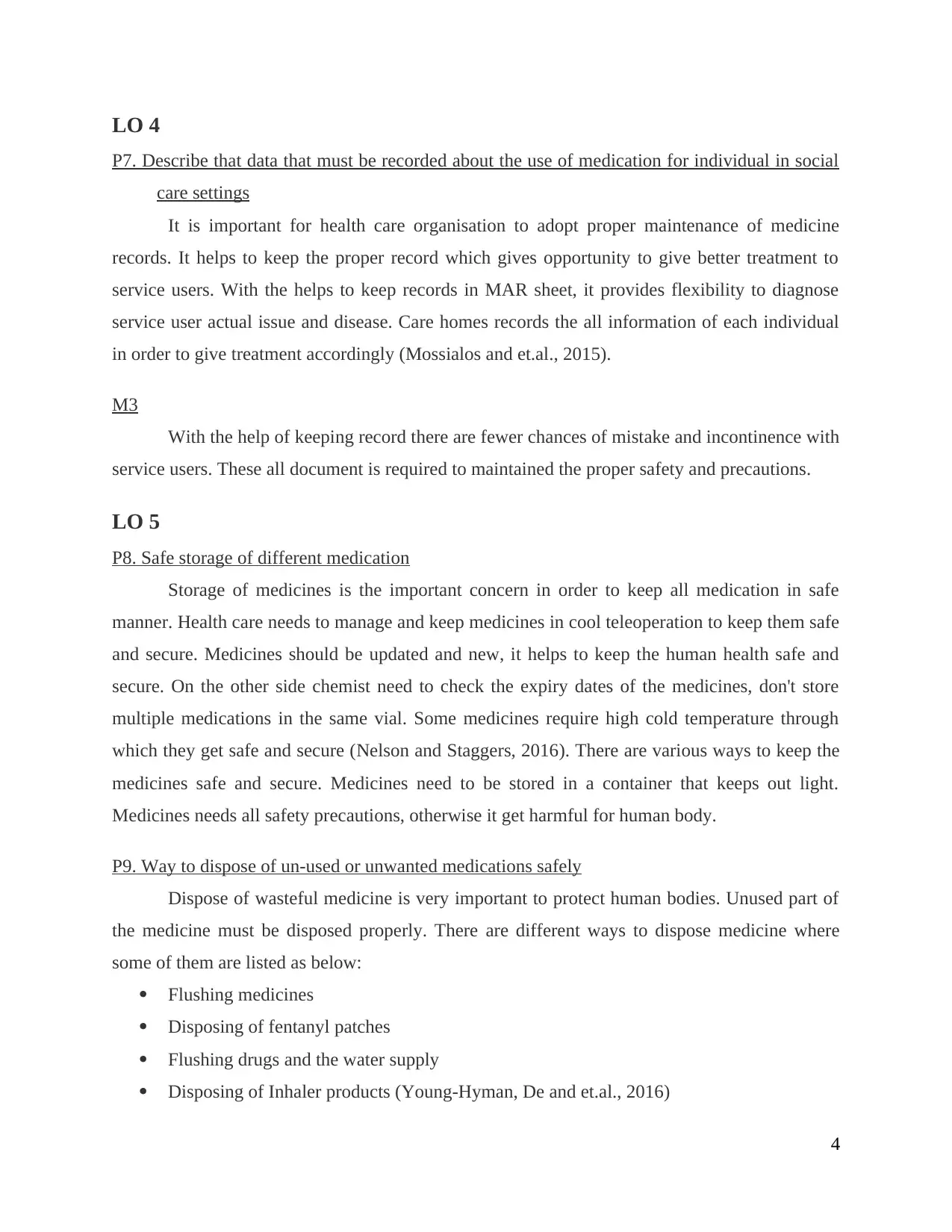
LO 4
P7. Describe that data that must be recorded about the use of medication for individual in social
care settings
It is important for health care organisation to adopt proper maintenance of medicine
records. It helps to keep the proper record which gives opportunity to give better treatment to
service users. With the helps to keep records in MAR sheet, it provides flexibility to diagnose
service user actual issue and disease. Care homes records the all information of each individual
in order to give treatment accordingly (Mossialos and et.al., 2015).
M3
With the help of keeping record there are fewer chances of mistake and incontinence with
service users. These all document is required to maintained the proper safety and precautions.
LO 5
P8. Safe storage of different medication
Storage of medicines is the important concern in order to keep all medication in safe
manner. Health care needs to manage and keep medicines in cool teleoperation to keep them safe
and secure. Medicines should be updated and new, it helps to keep the human health safe and
secure. On the other side chemist need to check the expiry dates of the medicines, don't store
multiple medications in the same vial. Some medicines require high cold temperature through
which they get safe and secure (Nelson and Staggers, 2016). There are various ways to keep the
medicines safe and secure. Medicines need to be stored in a container that keeps out light.
Medicines needs all safety precautions, otherwise it get harmful for human body.
P9. Way to dispose of un-used or unwanted medications safely
Dispose of wasteful medicine is very important to protect human bodies. Unused part of
the medicine must be disposed properly. There are different ways to dispose medicine where
some of them are listed as below:
Flushing medicines
Disposing of fentanyl patches
Flushing drugs and the water supply
Disposing of Inhaler products (Young-Hyman, De and et.al., 2016)
4
P7. Describe that data that must be recorded about the use of medication for individual in social
care settings
It is important for health care organisation to adopt proper maintenance of medicine
records. It helps to keep the proper record which gives opportunity to give better treatment to
service users. With the helps to keep records in MAR sheet, it provides flexibility to diagnose
service user actual issue and disease. Care homes records the all information of each individual
in order to give treatment accordingly (Mossialos and et.al., 2015).
M3
With the help of keeping record there are fewer chances of mistake and incontinence with
service users. These all document is required to maintained the proper safety and precautions.
LO 5
P8. Safe storage of different medication
Storage of medicines is the important concern in order to keep all medication in safe
manner. Health care needs to manage and keep medicines in cool teleoperation to keep them safe
and secure. Medicines should be updated and new, it helps to keep the human health safe and
secure. On the other side chemist need to check the expiry dates of the medicines, don't store
multiple medications in the same vial. Some medicines require high cold temperature through
which they get safe and secure (Nelson and Staggers, 2016). There are various ways to keep the
medicines safe and secure. Medicines need to be stored in a container that keeps out light.
Medicines needs all safety precautions, otherwise it get harmful for human body.
P9. Way to dispose of un-used or unwanted medications safely
Dispose of wasteful medicine is very important to protect human bodies. Unused part of
the medicine must be disposed properly. There are different ways to dispose medicine where
some of them are listed as below:
Flushing medicines
Disposing of fentanyl patches
Flushing drugs and the water supply
Disposing of Inhaler products (Young-Hyman, De and et.al., 2016)
4
⊘ This is a preview!⊘
Do you want full access?
Subscribe today to unlock all pages.

Trusted by 1+ million students worldwide
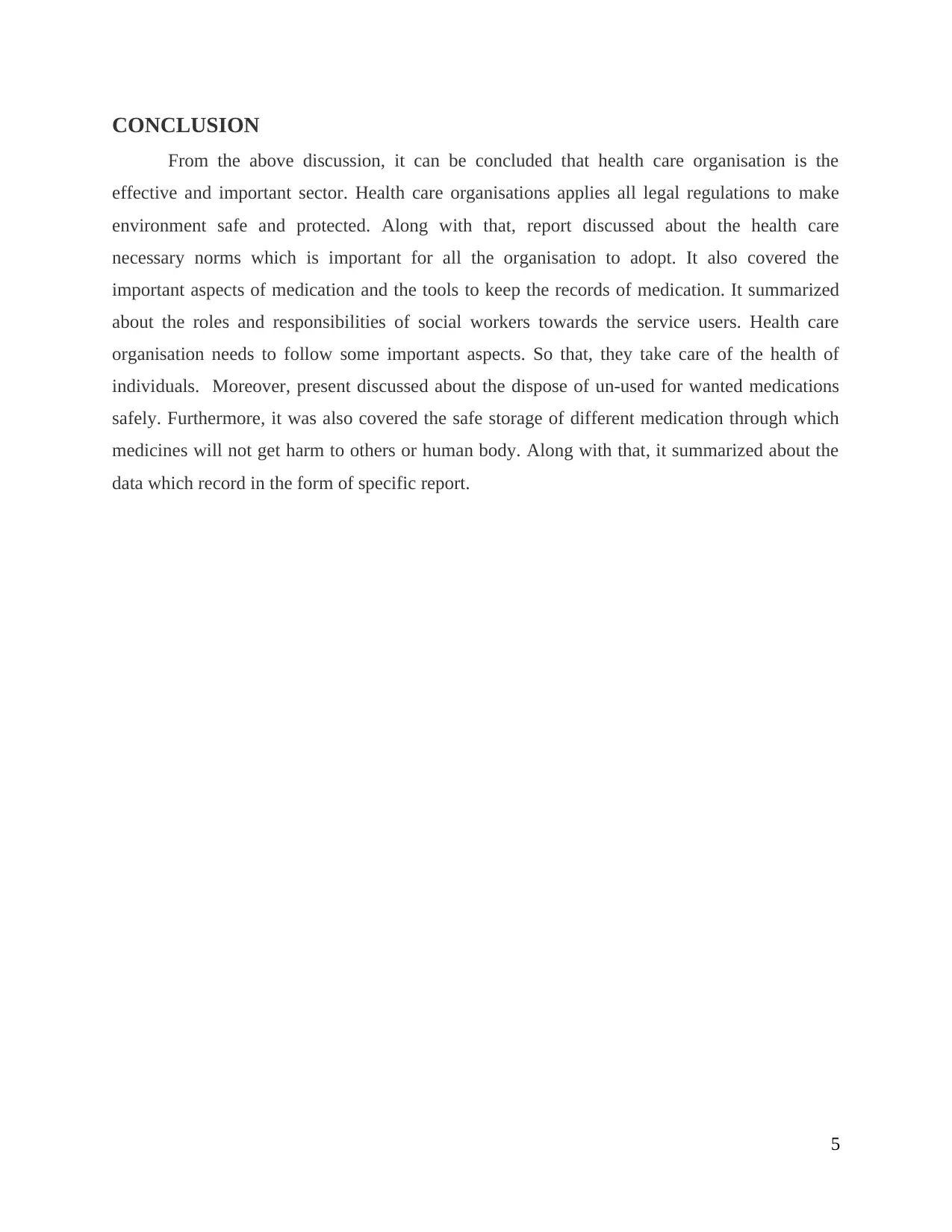
CONCLUSION
From the above discussion, it can be concluded that health care organisation is the
effective and important sector. Health care organisations applies all legal regulations to make
environment safe and protected. Along with that, report discussed about the health care
necessary norms which is important for all the organisation to adopt. It also covered the
important aspects of medication and the tools to keep the records of medication. It summarized
about the roles and responsibilities of social workers towards the service users. Health care
organisation needs to follow some important aspects. So that, they take care of the health of
individuals. Moreover, present discussed about the dispose of un-used for wanted medications
safely. Furthermore, it was also covered the safe storage of different medication through which
medicines will not get harm to others or human body. Along with that, it summarized about the
data which record in the form of specific report.
5
From the above discussion, it can be concluded that health care organisation is the
effective and important sector. Health care organisations applies all legal regulations to make
environment safe and protected. Along with that, report discussed about the health care
necessary norms which is important for all the organisation to adopt. It also covered the
important aspects of medication and the tools to keep the records of medication. It summarized
about the roles and responsibilities of social workers towards the service users. Health care
organisation needs to follow some important aspects. So that, they take care of the health of
individuals. Moreover, present discussed about the dispose of un-used for wanted medications
safely. Furthermore, it was also covered the safe storage of different medication through which
medicines will not get harm to others or human body. Along with that, it summarized about the
data which record in the form of specific report.
5
Paraphrase This Document
Need a fresh take? Get an instant paraphrase of this document with our AI Paraphraser
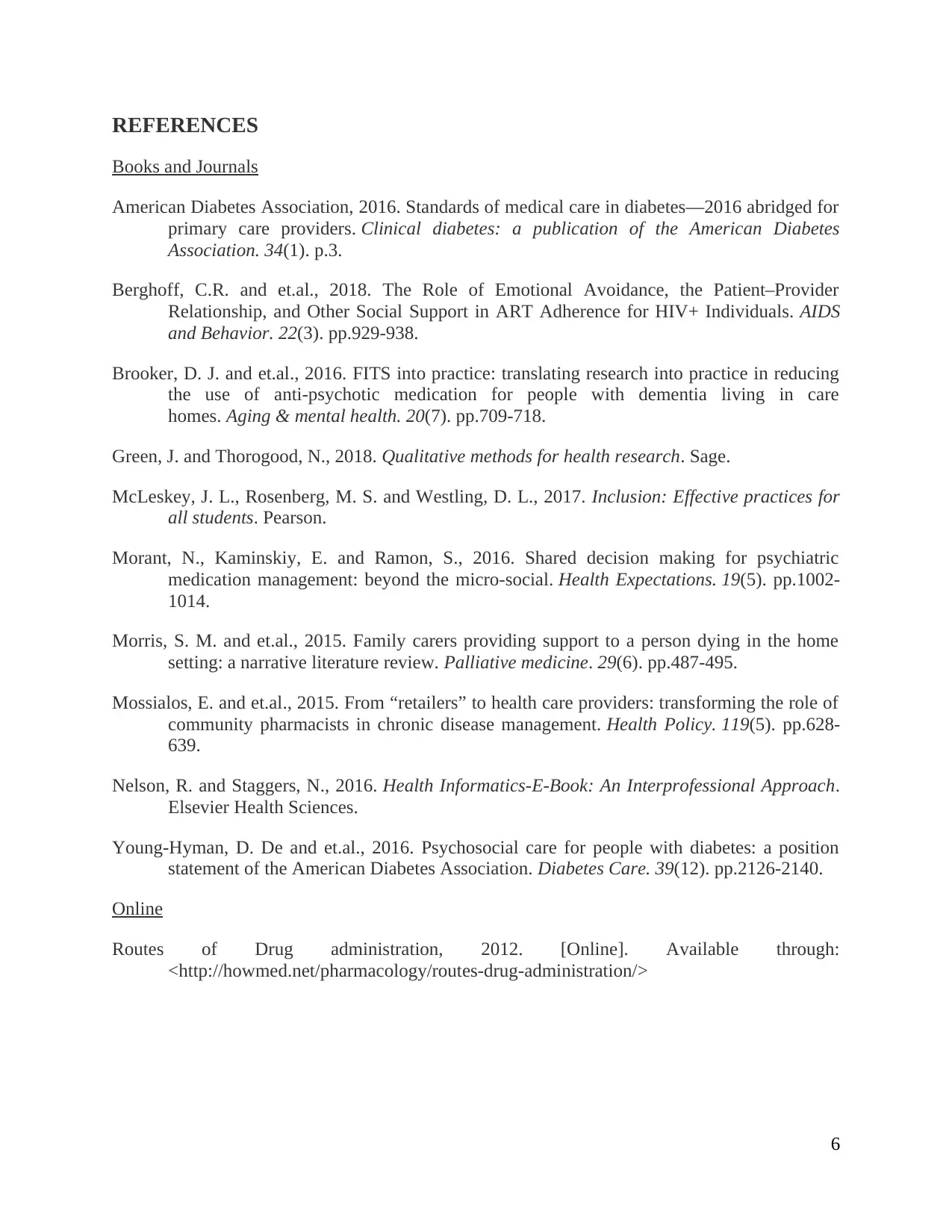
REFERENCES
Books and Journals
American Diabetes Association, 2016. Standards of medical care in diabetes—2016 abridged for
primary care providers. Clinical diabetes: a publication of the American Diabetes
Association. 34(1). p.3.
Berghoff, C.R. and et.al., 2018. The Role of Emotional Avoidance, the Patient–Provider
Relationship, and Other Social Support in ART Adherence for HIV+ Individuals. AIDS
and Behavior. 22(3). pp.929-938.
Brooker, D. J. and et.al., 2016. FITS into practice: translating research into practice in reducing
the use of anti-psychotic medication for people with dementia living in care
homes. Aging & mental health. 20(7). pp.709-718.
Green, J. and Thorogood, N., 2018. Qualitative methods for health research. Sage.
McLeskey, J. L., Rosenberg, M. S. and Westling, D. L., 2017. Inclusion: Effective practices for
all students. Pearson.
Morant, N., Kaminskiy, E. and Ramon, S., 2016. Shared decision making for psychiatric
medication management: beyond the micro‐social. Health Expectations. 19(5). pp.1002-
1014.
Morris, S. M. and et.al., 2015. Family carers providing support to a person dying in the home
setting: a narrative literature review. Palliative medicine. 29(6). pp.487-495.
Mossialos, E. and et.al., 2015. From “retailers” to health care providers: transforming the role of
community pharmacists in chronic disease management. Health Policy. 119(5). pp.628-
639.
Nelson, R. and Staggers, N., 2016. Health Informatics-E-Book: An Interprofessional Approach.
Elsevier Health Sciences.
Young-Hyman, D. De and et.al., 2016. Psychosocial care for people with diabetes: a position
statement of the American Diabetes Association. Diabetes Care. 39(12). pp.2126-2140.
Online
Routes of Drug administration, 2012. [Online]. Available through:
<http://howmed.net/pharmacology/routes-drug-administration/>
6
Books and Journals
American Diabetes Association, 2016. Standards of medical care in diabetes—2016 abridged for
primary care providers. Clinical diabetes: a publication of the American Diabetes
Association. 34(1). p.3.
Berghoff, C.R. and et.al., 2018. The Role of Emotional Avoidance, the Patient–Provider
Relationship, and Other Social Support in ART Adherence for HIV+ Individuals. AIDS
and Behavior. 22(3). pp.929-938.
Brooker, D. J. and et.al., 2016. FITS into practice: translating research into practice in reducing
the use of anti-psychotic medication for people with dementia living in care
homes. Aging & mental health. 20(7). pp.709-718.
Green, J. and Thorogood, N., 2018. Qualitative methods for health research. Sage.
McLeskey, J. L., Rosenberg, M. S. and Westling, D. L., 2017. Inclusion: Effective practices for
all students. Pearson.
Morant, N., Kaminskiy, E. and Ramon, S., 2016. Shared decision making for psychiatric
medication management: beyond the micro‐social. Health Expectations. 19(5). pp.1002-
1014.
Morris, S. M. and et.al., 2015. Family carers providing support to a person dying in the home
setting: a narrative literature review. Palliative medicine. 29(6). pp.487-495.
Mossialos, E. and et.al., 2015. From “retailers” to health care providers: transforming the role of
community pharmacists in chronic disease management. Health Policy. 119(5). pp.628-
639.
Nelson, R. and Staggers, N., 2016. Health Informatics-E-Book: An Interprofessional Approach.
Elsevier Health Sciences.
Young-Hyman, D. De and et.al., 2016. Psychosocial care for people with diabetes: a position
statement of the American Diabetes Association. Diabetes Care. 39(12). pp.2126-2140.
Online
Routes of Drug administration, 2012. [Online]. Available through:
<http://howmed.net/pharmacology/routes-drug-administration/>
6
1 out of 8
Related Documents
Your All-in-One AI-Powered Toolkit for Academic Success.
+13062052269
info@desklib.com
Available 24*7 on WhatsApp / Email
![[object Object]](/_next/static/media/star-bottom.7253800d.svg)
Unlock your academic potential
Copyright © 2020–2025 A2Z Services. All Rights Reserved. Developed and managed by ZUCOL.





